6 Textile artists using recycled materials
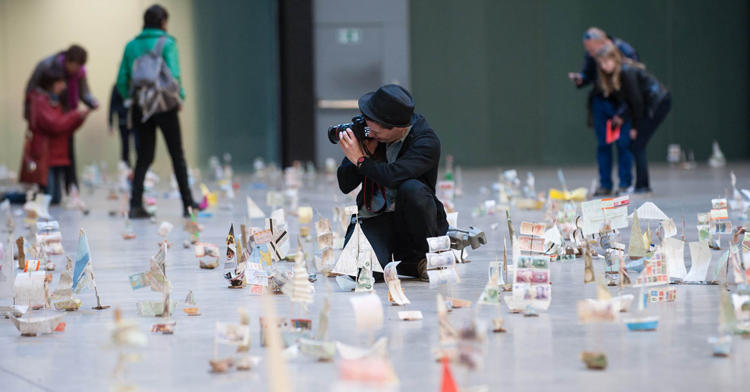
Recycling in art is not a new concept, but practitioners working with textiles seem to be discovering evermore innovative means of harnessing this abundant source of raw materials. The range of textile art being created from recycled or reclaimed goods is testament to the versatility offered by making use of stuff that has had a life already; a life that is often purely functional and as far removed from ‘art’ as you can imagine.
The appeal to the textile artist using recycled materials goes much deeper than an easing of their social conscious! The materials being used often have an inherent history, which can offer a powerful starting point and make for a more meaningful process. Collectors and art-lovers will also potentially connect with the finished artwork on a deeper level if they are privy to its story.
Today we explore the work of 6 diverse textile artists doing incredible things with recycled materials.
1, Su Blackwell
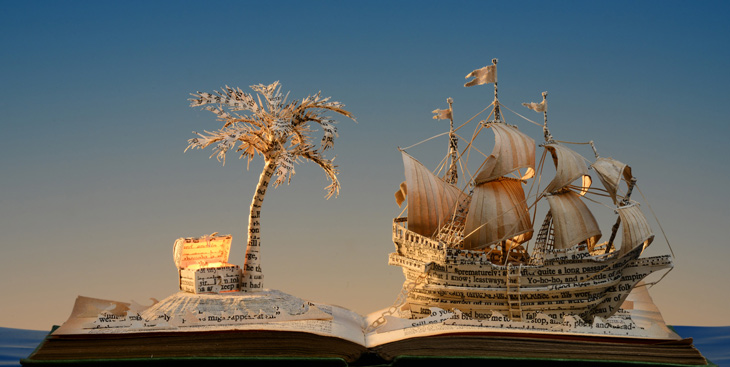
Su Blackwell – Treasure Island, 2013
Su Blackwell‘s textile training plays a vital role in the creation of her exquisite book sculptures. As noted by Justin Croft (Antiquarian Bookseller) ‘Each letter is like a stitch; it’s as if she’s weaving with words‘.
Working predominantly with paper, Su uses intricate cutwork to bring her 3-dimensional illustrations to life. The use of old book pages as source material not only hints at melancholy (supported by the extensive use of muted and subtle shades), but it also creates a direct connection to the themes Su often explores; fairy tales and folklore.
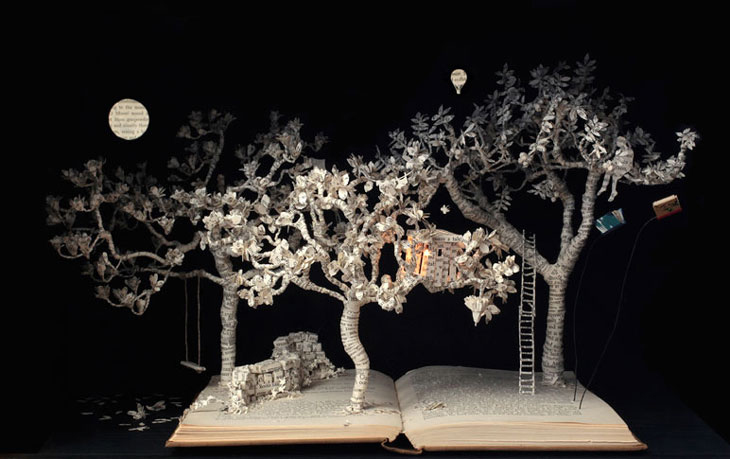
Su Blackwell, The Baron in the Trees, 2011
There is a dark and sometimes eery quality to these dioramas, which often depict young girls lost in haunting locations. This subject seems to marry perfectly with the use of such a delicate material and highlights the vulnerability of youth and the fragility of life.
Much of Su’s work is beautifully framed in display boxes, which adds to its sense of surrealism and theatricality.
In recent years Su has diversified, but usually sticking within the realm of fairy tales; she designed the set for a production of The Snow Queen at the Rose Theatre in Kingston in 2011, and released an illustrated book entitled ‘The Fairytale Princess‘ in 2012.
Find out more about Su at SuBlackwell.co.uk
2, Natasha Kerr
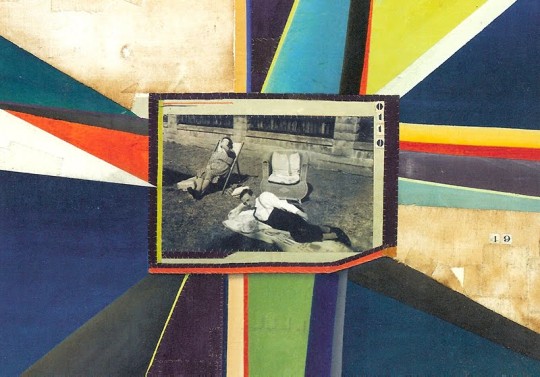
Natasha Kerr – At the End of the Day
Natasha Kerr uses old photos from her own family album and combines them with vintage fabrics and trims to create her distinctive brand of recycled textile art.
The stories embedded in both the black and white/sepia images and the fabrics used give Natasha’s work a depth that is very appealing to the viewer and triggers an emotional response.
In 1998 Natasha’s work took over an entire Victorian townhouse in Battersea, London; the teaming of a historical venue with a multi-sensual experience gave the artist’s figurative work a contextual setting that was both moving and uncomfortable. Aptly named ‘There are things you don’t need to know’, the exhibition painted a poignant picture of family life through the ages.
In recent years, Natasha has been taking commissions to create works that tell the stories of families other than her own.
For more information about Natasha visit NatashaKerr.co.uk
3, Susan Stockwell

Susan Stockwell – Sail Away, 2013
Susan Stockwell is not an artist who is content to work in one medium or style; her work ranges from tiny intricate studies to huge elaborate installations. She uses a combination of sculpture, drawing, collage, stitch and weave to create politically charged work exploring issues of trade, history, ecology, and mapping.
Susan uses source materials that may have started life in domestic or industrial settings, but that are common-place and familiar, such as maps and currency. These items are then recycled through manipulation and often fused together using stitch to become extraordinary pieces of art.

Susan Stockwell – Stack with Freefall in background, 2008
Borrowing materials is a recurring element of Susan’s work; in these instances, the recycling continues. For example, her exhibition Flood was created from 4 tons of recycled computer components; these were re-invented as an installation in a 13th-century church in York. Once the exhibition was over, the computer parts were returned to Secure IT Recycling to begin a new life elsewhere.
Curator Grace Chung gave a pertinent evaluation of Susan’s work in the text for the exhibition B-Side Ecology in Taiwan: “Meticulously hand crafted, the benign sublime beauty in the work belies the devastating effects of our culture and our role in shaping it. Look more closely, and one is confronted by a cultural urgency of global-proportions“.
Find out more about Susan at SusanStockwell.co.uk
4, Louise Baldwin
62 Group member Louise Baldwin is a textile artist using recycled materials and found objects. She combines hand and machine embroidery to create collaged wall hangings constructed from ‘the mundane waste of domestic packaging‘.
Louise’s artwork depicts the hectic nature of her own life. She gathers anything she can get her hands on from around the home, including card form toys, medication boxes, biscuit wrappers and layers them, building up the collage as she goes with the sewing machine. There is nothing pre-planned about this process; this is an artist relying entirely on instinct.
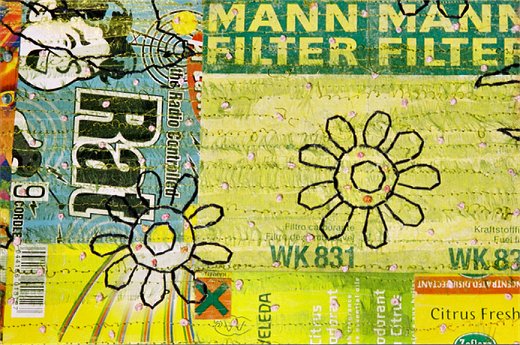
Louise Baldwin – For Indoor Use Only (detail)
Finally, once the background is in place, ‘naive’ or ‘idyllic’ images are hand stitched onto the surface.
Over time, Louise’s work has become a metaphor for human behaviour; the everyday and seemingly ordinary daily activities juxtaposed with the potential of our imagination and its engagement with our hopes and desires.
To find out more about Louise visit the 62 Group website.
5, Jennifer Collier
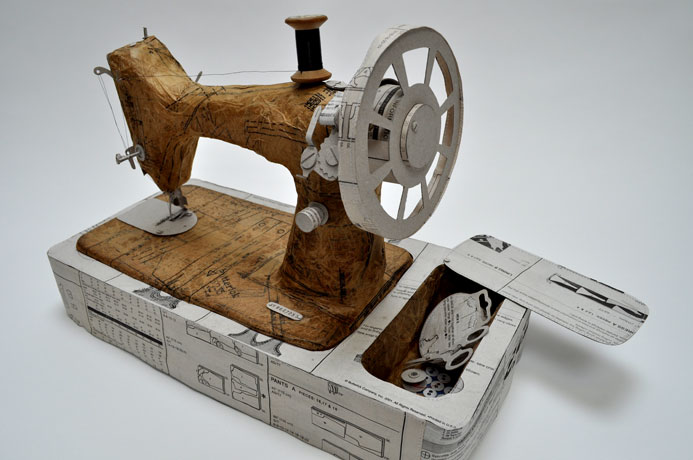
Jennifer Collier – Singer Sewing Machine
Jennifer Collier creates incredibly detailed 3D works from paper; the subjects are normally household objects.
She recycles vintage papers (sometimes from old books) and tea bags (amongst other things) which she bonds and waxes to create ‘fabric’. This material is then treated as if it is cloth and stitched together to build the sculptures.
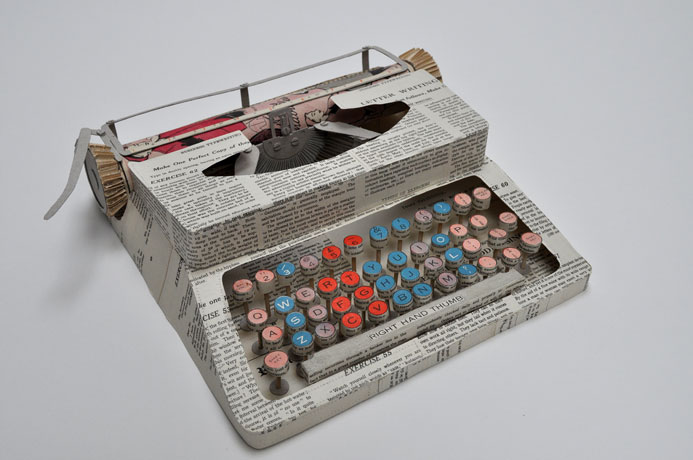
Jennifer Collier – Typewriter
Once again with Jennifer’s work, we see how recycled materials become both the media and the inspiration. The narrative of the books and pages informs what should be created from them.
The uniqueness of this work comes from using traditional textile techniques in a new way to resurrect and transform paper that might otherwise be discarded.
For more information about Jennifer’s work visit JenniferCollier.co.uk
6, Jane Perkins
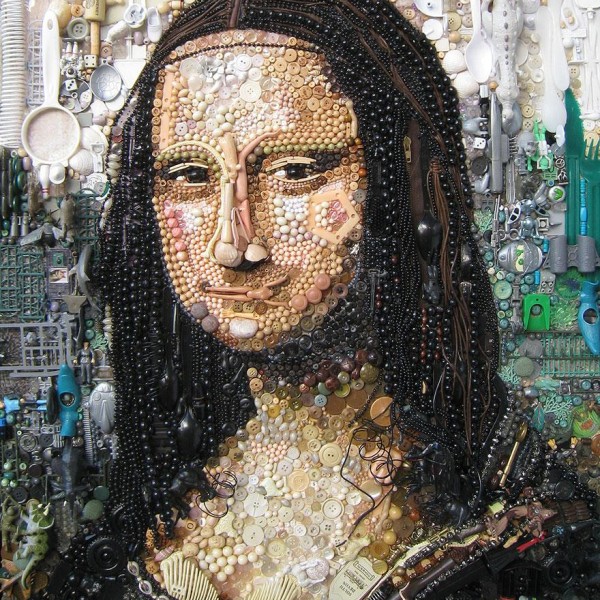
Jane Perkins – Mona Lisa (Plastic Classics)
Jane Perkins categorises herself as a ‘re-maker’ and is well-versed in recycling for art, having written an entire thesis on it!
Jane’s current body of work is entitled ‘Plastic Classics’. For the creation of this collection, Jane takes unwanted objects and uses collage techniques influenced by her background in textiles to create reproductions of artworks by the old masters.
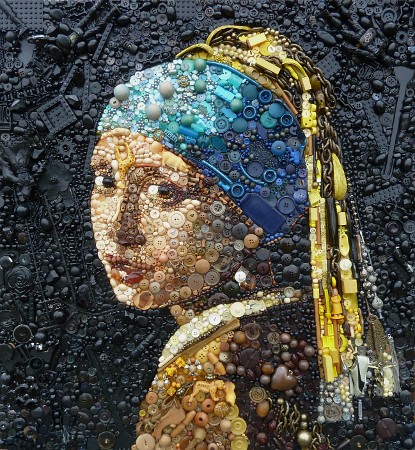
Jane Perkins – Girl with the Pearl Earring (Plastic Classics)
Tracy Chevalier, author of the novel Girl with a Pearl Earring, praised Jane’s interpretation of the painting by the same name by writing “Jane Perkins has taken the portrait a step beyond and made it her own – a textured image that I bet would have made Vermeer smile“.
Humour is central to the concept of using unwanted and seemingly worthless plastic items to reinterpret priceless pieces of classic art.
To see more of Jane’s work visit BlueBowerBird.co.uk
Other textile artists using recycled materials (featured on TextileArtist.org)
If you’ve enjoyed this article don’t forget to share it on Facebook or Twitter using the buttons below.

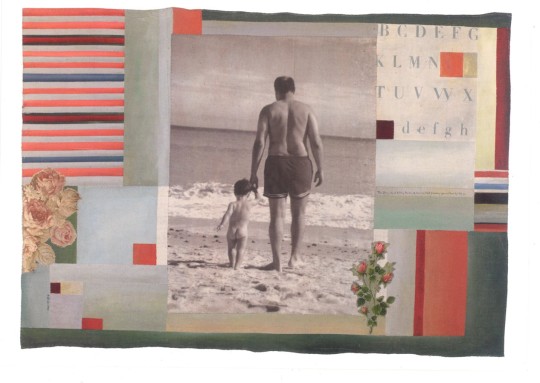
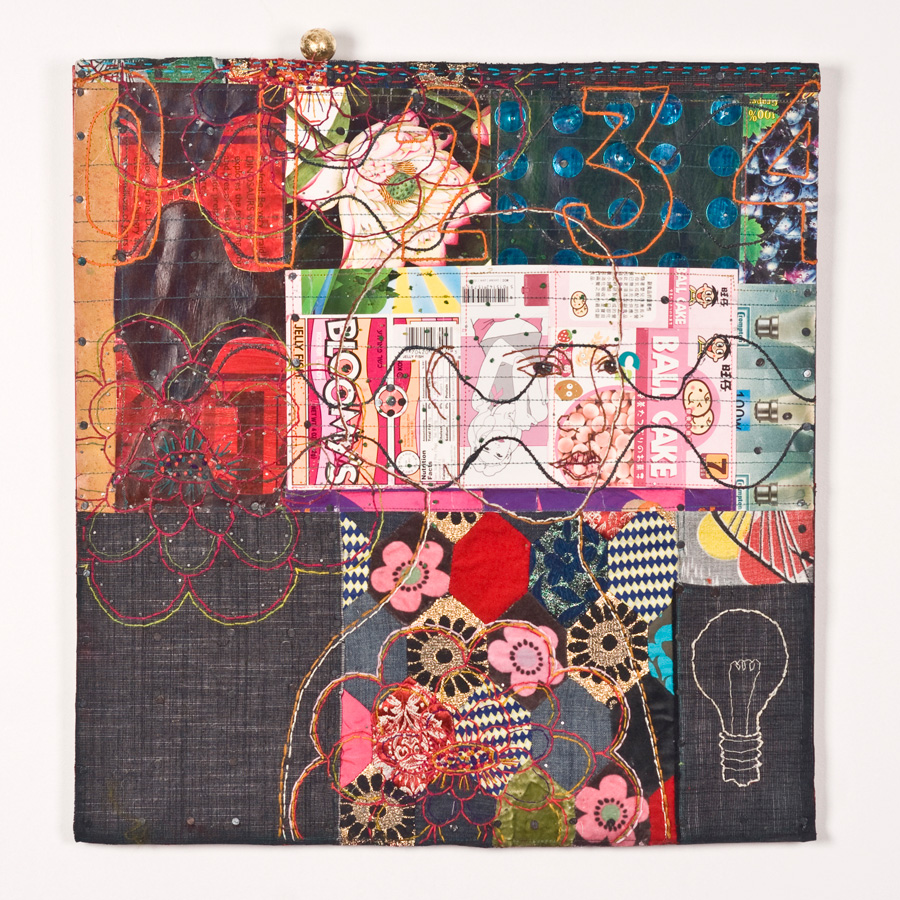















When I started working with abandoned fabrics 20 years ago, I thought it was just my predilection for old lace and linens. But now I see my work falls in a historical trend (can we be anything but of our own time?). So many fine artists doing interesting things with abandoned materials… of which we have way too many, nowadays.
Ooooohhhhh, these are all so wonderful! Using recycled materials is a big priority for me with my own work and I just love seeing how people manipulate things in new ways. I have a small collection of recycled tin and bottle cap art and several transport pieces made out of wire or pop bottles (cars, bicycle, airplanes…).
Aside from the environmental value, which is the key point for me, cutting out the cost on supplies makes a huge difference for artists. There are quite a few fabric companies that make small runs of fabric aimed at quilters and they can run between $7-$9 a yard! (US $). A quilt with new, commercial fabrics can easily have over $100 invested into it just in supplies. Most of my fabric is from garments that I cut up from thrift stores.
I recently wrote a post about what recycling means to the handmade community and hope that you will visit: http://artizanmade.com/value-recycling-handmade-community/ The arts and craft supply industry is huge and although I am grateful that we have so many places to find the tools and things that we need (even if most of it is now online), I think we should all be proactive at using our own waste as much as possible. Junk Culture is a wonderful site that documents what people are doing: http://www.junk-culture.com/ Maybe they can also feature those of you who are using junk to make art!
Kudos to all of you!
Rachel
You should add Suendrini Goonesekera to the list. She makes large textile landscapes from discarded textiles from te design industry. She used no glues or dyes and most of all her work if mind blowing.
Her web site is http://www.suendrini.com. Her first show was Art in the County 2013 where she was honoured with the Manly E. MacDonald Award of Excellence.
Suendrini’s work looks like a good addition – Thanks for sharing Sean
I love using stuff that is discarded.In the far south west we have a thriving rug group,”We are not doormats”,and we make so many varied and unique pieces,for floors,walls,furniture,etc. all from cutting up old clothes.Each year we transform a local village hall with rugs,completely covering every available surface,purely and simply for the joy of doing it and to give people pleasure! it’s a wonderful feeling to stand in the middle of the room and to think that everything there was made from discarded garments.
You should add Jo Atherton to the list. She collects rubbish from beaches…alsorts of marine waste and makes the most intricate weaving x
There are much more with textile artist using upcycle materials than the ones in your list
Absolutely! Would you care to share with us some of your favourites?
20 years ago people laughed at me. It brightens my heart as I can see, this type of art is fashionable and popular now. I wonder if you like my “upcycled” work:
http://krystynarecycled.blogspot.com
Thank you for sharing awesome textile artists using recycled materials. Cheers!
Great Article! I am an artist that up cycles and recycles for my art and my own own wardrobe. I am a big supporter of thrift store fashion and household linens. When things cycle out of my closets , they end up in the “art pile” awaiting a new life as fine art. If you are interested check out what I do with old sweaters, towels, blankets, etc. (Haven’t stooped to using underwear yet) , on my website.
I was born to my refugee parents during WW2, my mother returned with me t Holland to find she lost her whole famile , and she strated life from scrap. Than we moved to Israel than a young country abosorbing many refugees, Thus from childhood i was taught not to throw away anything. sweaters were ripped and made into new sweaters, clothes were ripped and comined into new ones. `Boring ` plain clothes , were embroidered to look `nicer `and more Unique, we never complained anou needing we made what we needed and waht we could, I think this was my strat as a fibersrtist in later years. everything was copuld be rnewed , niot having much money was no reason not to have somethings. But we also never bought without thinking about waht we intend to buy. if and when buying we chose good stuff, that will last. in my art and my clothes i have cloth parts that are 6o years old ,,,,,, and i still have them .
I have been making a number of pieces using teabags in the last couple of months. A challenge for me as I usually work with really bright colours. But restrictions have really helped me to be more creative and look for different solutions.
I think u care for the environment
You should add Gwen Henley to your list of textile artists using found and recycled objects. She is teaching at TSG Summer School this year.
I refer to myself as a 21st century Womble, in homage to the old children’s TV programme The Wombles. The Wombles were little creatures who “Made good use of the things that they find, The things that the every day folk leave behind.” My shed is overflowing with goodies awaiting my inspiration – recycled fabrics, lace and other trims, beads, buttons, broken jewellery and other bits and pieces too numerous to mention. All put together with a vast collection of threads. Most of these treasures have come from thrift shops, or friends’ leavings from their projects, which would otherwise be discarded. My family and “non arty” friends think I am a little un-hinged, which is probably right, but I can get really excited about an ancient embroidered Japanese kimono or a worn out dress trimmed with exquisite lace or beautiful beading, and why not? As most of my work is based on Victorian Crazy Patchwork and appliqued landscapes, I am quite happy to disappear into my workroom for days on end just being creative and using my imagination. As I am hopeless with a pencil or brush, I design “on the hop,” never quite knowing where my work will take me.Probably not everyone’s cup of tea, but my work gives me great satisfaction.